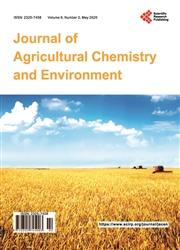Effect of Organic and Chemical Fertilizer Application on Growth, Yield, and Quality of Small-Sized Tomatoes
引用次数: 4
Abstract
Tomatoes in Japan are generally cultivated under management systems that use chemical fertilizers and synthetic chemical pesticides. However, the continuous use of these fertilizers and pesticides damages the soil environment and reduces the number of soil microorganisms. Organic farming has a relatively low environmental impact compared to conventional farming techniques, but typically has lower and more unstable yields. In this study, we investigated the effect of organic and chemical fertilizer application on growth, yield, and quality of small-sized (cherry) tomatoes. Cherry tomatoes were cultivated using organic and chemical organic fertilizers. Average weight and lateral diameter were significantly higher under organic fertilizer than under chemical fertilizer. In addition, shoot dry weight was significantly higher under organic fertilizer than chemical fertilizer. Lycopene content was significantly higher under organic fertilizer than chemical fertilizer. The total carbon (TC), total phosphorus (TP), total potassium (TK), available phosphoric (SP) and exchangeable potassium (SK) contents, C/N ratio, and pH were significantly higher under organic fertilizer than chemical fertilizer. Bacterial biomass, nitrite (NO? 2-N) oxidation activity, nitrification (N) circulation activity, and phosphoric (P) circulation were higher under organic fertilizer than chemical fertilizer. From these results, the study indicates that appropriate controls such as TC, total nitrogen (TN), and C/N ratio of organic fertilizer increased microbial biomass and enhanced nutrient circulation such as N circulation activity and P circulation activity. These results can be used to improve current organic farming practices and promote soil conservation.有机肥和化肥施用对小番茄生长、产量和品质的影响
在日本,番茄的种植管理系统通常使用化肥和合成化学农药。然而,这些肥料和农药的持续使用破坏了土壤环境,减少了土壤微生物的数量。与传统农业技术相比,有机农业对环境的影响相对较小,但通常产量较低且更不稳定。本试验研究了有机肥和化肥施用对小番茄生长、产量和品质的影响。圣女果的栽培使用有机和化学有机肥。有机肥处理的平均重和侧径显著高于化肥处理。此外,有机肥处理的地上部干重显著高于化肥处理。有机肥处理番茄红素含量显著高于化肥处理。有机肥处理土壤的总碳(TC)、全磷(TP)、全钾(TK)、速效磷(SP)和交换性钾(SK)含量、C/N比和pH显著高于化肥。细菌生物量,亚硝酸盐(NO?有机肥的2-N氧化活性、硝化(N)循环活性和磷(P)循环活性高于化肥。综上所述,适当控制有机肥总氮(TN)、总氮(TC)和碳氮比可增加微生物量,促进氮循环活性和磷循环活性等养分循环。这些结果可用于改进目前的有机耕作方法和促进土壤保持。
本文章由计算机程序翻译,如有差异,请以英文原文为准。
求助全文
约1分钟内获得全文
求助全文

 求助内容:
求助内容: 应助结果提醒方式:
应助结果提醒方式:


